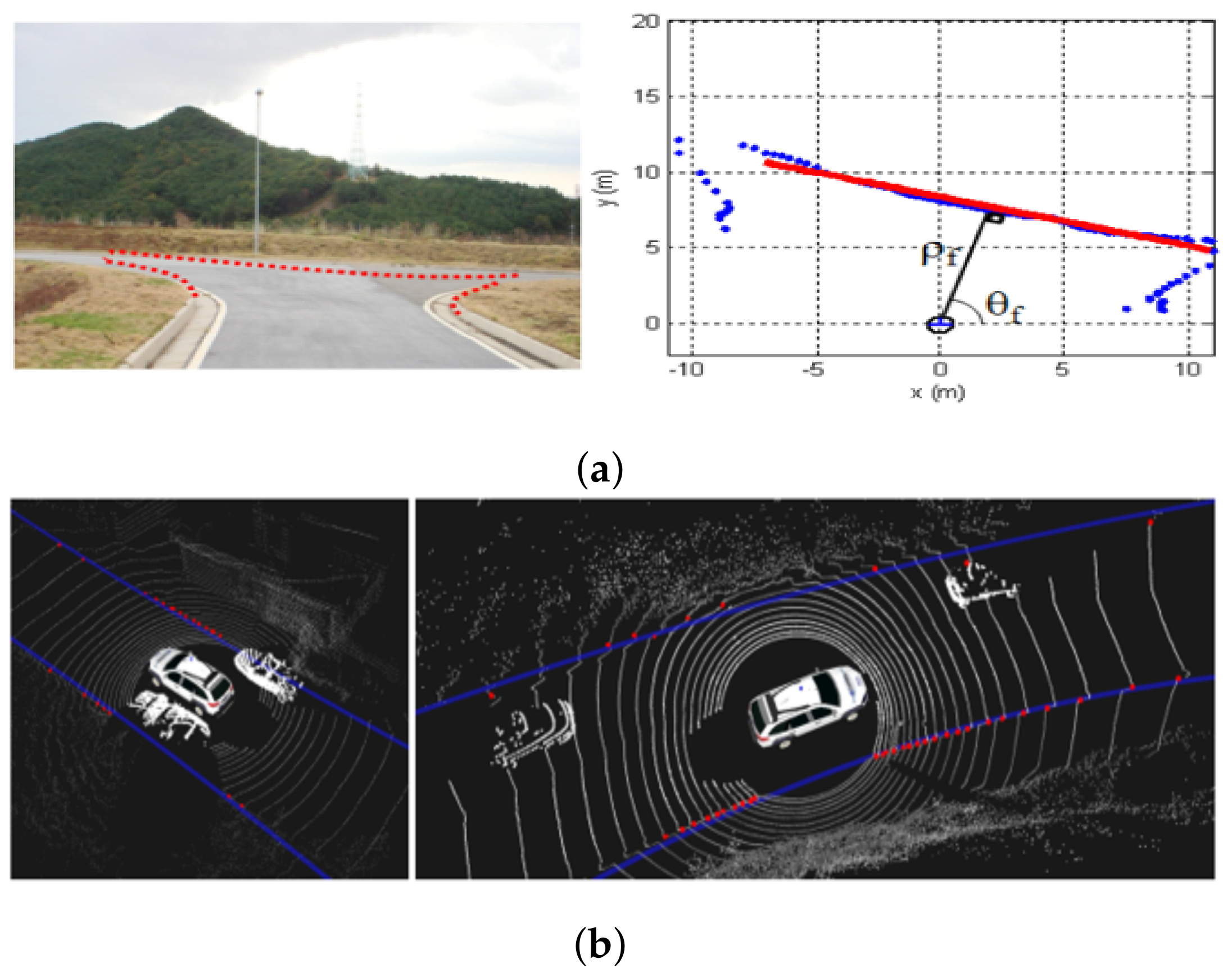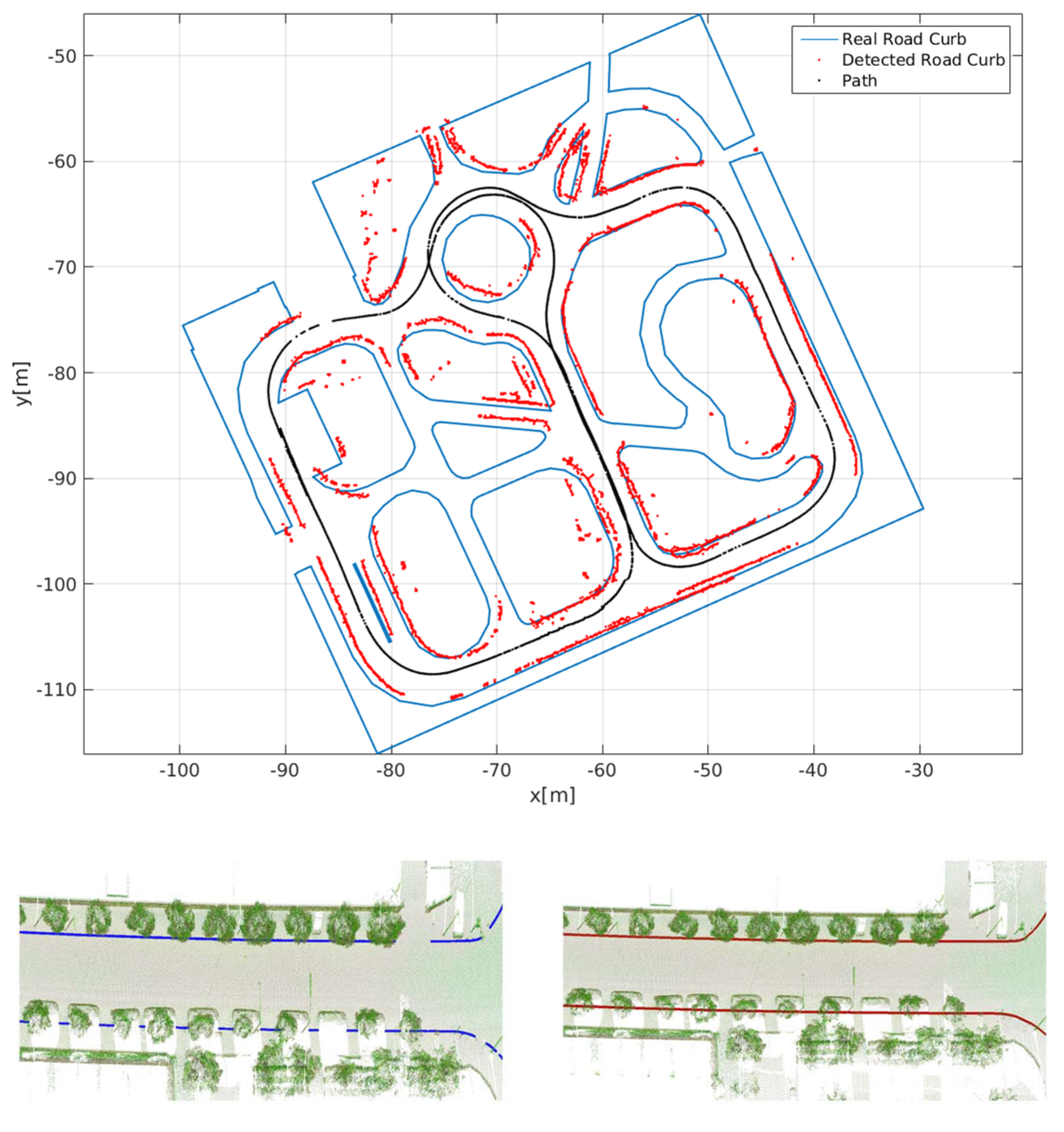Road Curb Detection: A Historical Survey
Abstract
:1. Introduction
Road Curb Detection Chronology
2. Curb Detection Methodology
2.1. Data Acquisition
2.1.1. Vision-Based
2.1.2. LiDAR-Based
2.1.3. Ultrasonic-Based
2.1.4. Multi-Modal
2.2. Pre-Processing
2.3. Data Representation
2.3.1. Digital Elevation Map
2.3.2. Point Clouds
2.3.3. Voxel Grids
2.4. Ground Segmentation
2.5. Feature Extraction/Attribute Extraction
2.5.1. Height Step
2.5.2. Height Gradient
2.5.3. Normal Orientation
2.5.4. Slope Angle
2.5.5. Conic Section Compression
2.5.6. Tangential Angle
2.5.7. Curvature
2.5.8. Smoothness
2.5.9. Smooth Arc Length
2.5.10. Hough Transform
2.5.11. Line Segment Analysis
2.5.12. Elevation Histogram
2.5.13. Laser Reflectance
2.5.14. Integral Laser Point
2.5.15. Radon Transform
2.5.16. Discrete Haar Wavelet
2.5.17. Texture
2.5.18. Histogram of Oriented Gradients (HOG)
2.5.19. Bayesian Filter
2.5.20. Local Binary Patterns
2.6. Road Curb Detection
2.6.1. Thresholding
2.6.2. Classification
2.6.3. Post-Processing
2.7. Tracking
2.8. Road Curb Detection Methods over Time
3. Applications
3.1. Localization
3.2. Curbs Mapping
3.3. Road Curb Modeling
- The polynomial fitting model: To extract a mathematical model for detected curbs, the authors of [6] use lines, and in [7], a polyline model is used. In [19,37], road curbs are modeled using a parabola model. The authors of [8] propose to use a cubic polynomial instead of lines or polylines. A cubic polynomial allows to keep curvatures and their variations and they are in accordance with the clothoidal model for road lane boundaries. Cubic polynomial fitting has been used in [64]. Since the polynomial fitting problem is often overdetermined, they are solved using a least-squares method. A quadratic polynomial model has been used in [12,24,30] while [12] uses a cubic polynomial model to extract curved road curbs from candidate curb points.
- Spline curb model: A cubic spline has been used in [32] to improve curb modeling. The cubic spline interpolation is solved using least-squares minimization. The optimization follows an iterative approach until the optimal configuration of knots is selected. The increased complexity of using multiple iterations on the least square minimization is avoided by fitting the first polynomial inside its interval. The kth polynomial is fitted after it fulfills the continuity constraint. The authors of [56] use a cubic Bezier curve to fit extracted road curb points to model road curbs. The vectorized road curbs are then used to compute some road geometry parameters, such as driving free space, road width, road slope, horizontal curvature, etc.
- Support vector regression (SVR): Curb fitting using a support vector regression (SVR) was proposed in [54] that can handle high-dimensional and nonlinear problems. Results reported by [54] show that SVR improves the modeling of curved curbs with respect to linear [82] and cubic polynomial methods [8].
4. Future Challenges and Trends
Author Contributions
Funding
Institutional Review Board Statement
Informed Consent Statement
Data Availability Statement
Conflicts of Interest
References
- Guerrero, J.; Chapuis, R.; Aufrère, R.; Malaterre, L.; Marmoiton, F. Road Curb Detection using Traversable Ground Segmentation: Application to Autonomous Shuttle Vehicle Navigation. In Proceedings of the IEEE International Conference on Automation, Robotics and Computer Vision, Shenzhen, China, 13–15 December 2020. [Google Scholar]
- Aufrere, R.; Mertz, C.; Thorpe, C. Multiple sensor fusion for detecting location of curbs, walls, and barriers. In Proceedings of the IEEE Intelligent Vehicles Symposium (IV), Columbus, OH, USA, 9–11 June 2003; pp. 126–131. [Google Scholar]
- Wijesoma, W.S.; Kodagoda, K.R.S.; Balasuriya, A.P. Road-boundary detection and tracking using ladar sensing. IEEE Trans. Robot. Autom. 2004, 20, 456–464. [Google Scholar] [CrossRef]
- Wang, R.B.; Gu, B.Y.; Jin, L.S.; Yu, T.H.; Gou, L. Study on curb detection method based on 3D range image by LaserRadar. In Proceedings of the IEEE Intelligent Vehicles Symposium (IV), Las Vegas, NV, USA, 6–8 June 2005; pp. 845–848. [Google Scholar]
- Kim, S.H.; Roh, C.; Kang, S.C.; Park, M.Y. Outdoor Navigation of a Mobile Robot Using Differential GPS and Curb Detection. In Proceedings of the IEEE International Conference on Robotics and Automation (ICRA), Roma, Italy, 10–14 April 2007; pp. 3414–3419. [Google Scholar]
- Oniga, F.; Nedevschi, S.; Meinecke, M.M. Curb Detection Based on Elevation Maps from Dense Stereo. In Proceedings of the IEEE International Intelligent Computer Communication and Processing, Cluj-Napoca, Romania, 6–8 September 2007; pp. 119–125. [Google Scholar]
- Oniga, F.; Nedevschi, S.; Meinecke, M.M. Curb Detection Based on a Multi-Frame Persistence Map for Urban Driving Scenarios. In Proceedings of the IEEE International Conference on Intelligent Transportation Systems (ITSC), Beijing, China, 12–15 October 2008; pp. 67–72. [Google Scholar]
- Oniga, F.; Nedevschi, S. Polynomial curb detection based on dense stereovision for driving assistance. In Proceedings of the IEEE International Conference on Intelligent Transportation Systems (ITS), Funchal, Portugal, 19–22 September 2010; pp. 1110–1115. [Google Scholar]
- Stuckler, J.; Schulz, H.; Behnke, S. In-lane Localization in Road Networks using Curbs Detected in Omnidirectional Height Images. Vdibericht 2008, 2012, 151. [Google Scholar]
- Siegemund, J.; Pfeiffer, D.; Franke, U.; Farstner, W. Curb reconstruction using Conditional Random Fields. In Proceedings of the IEEE Intelligent Vehicles Symposium (IV), La Jolla, CA, USA, 21–24 June 2010; pp. 203–210. [Google Scholar]
- Maye, J.; Kaestner, R.; Siegwart, R. Curb detection for a pedestrian robot in urban environments. In Proceedings of the IEEE International Conference on Robotics and Automation, St. Paul, MN, USA, 14–18 May 2012; pp. 367–373. [Google Scholar]
- Liu, Z.; Liu, D.; Chen, T.; Wei, C. Curb Detection Using 2D Range Data in a Campus Environment. In Proceedings of the IEEE International Conference on Image and Graphics, Qingdao, China, 26–28 July 2013; pp. 291–296. [Google Scholar]
- Liu, Z.; Wang, J.; Liu, D. A New Curb Detection Method for Unmanned Ground Vehicles Using 2D Sequential Laser Data. Sensors 2013, 13, 1102–1120. [Google Scholar] [CrossRef] [Green Version]
- Kellner, M.; Bouzouraa, M.; Hofmann, U. Road curb detection based on different elevation mapping techniques. In Proceedings of the IEEE Intelligent Vehicles Symposium (IV), Dearborn, MI, USA, 8–11 June 2014; pp. 1217–1224. [Google Scholar] [CrossRef]
- Peterson, K.; Ziglar, J.; Rybski, P.E. Fast Feature Detection and Stochastic Parameter Estimation of Road Shape using Multiple LIDAR. In Proceedings of the 2008 IEEE/RSJ International Conference on Intelligent Robots and Systems (IROS), Nice, France, 22–26 September 2008; pp. 612–619. [Google Scholar]
- El Halawany, S.; Moussa, A.; Lichti, D.D.; El Sheimy, N. Detection of Road Curb from Mobile Terrestrial Laser Scanner Point Cloud. Intl. Arch. Photogramm. Remote Sens. Spat. Inf. Sci. 2011, 38, 109–114. [Google Scholar] [CrossRef] [Green Version]
- Liu, J.; Liang, H.; Wang, Z.; Chen, X. A Framework for Applying Point Clouds Grabbed by Multi-Beam LIDAR in Perceiving the Driving Environment. Sensors 2015, 15, 21931–21956. [Google Scholar] [CrossRef] [PubMed] [Green Version]
- Yu, Y.; Guan, H.; Ji, Z. Automated Detection of Urban Road Manhole Covers Using Mobile Laser Scanning Data. IEEE Trans. Intell. Transp. Syst. 2015, 16, 3258–3269. [Google Scholar] [CrossRef]
- Zhao, G.; Yuan, J. Curb detection and tracking using 3D-LIDAR scanner. In Proceedings of the 2012 19th IEEE International Conference on Image Processing, Orland, FL, USA, 30 September–3 October 2012; pp. 437–440. [Google Scholar]
- Seibert, A.; Hohnel, M.; Tewes, A.; Rojas, R. Camera based detection and classification of soft shoulders, curbs and guardrails. In Proceedings of the IEEE Intelligent Vehicles Symposium (IV), Gold Coast City, Australia, 23–26 June 2013; pp. 853–858. [Google Scholar]
- Strygulec, S.; Muller, D.; Meuter, M.; Nunn, C.; Ghosh, S.L.; Wohler, C. Road Boundary Detection and Tracking Using Monochrome Camera Images. In Proceedings of the International Conference on Information Fusion, Istanbul, Turkey, 9–12 July 2013. [Google Scholar]
- Chen, T.; Dai, B.; Liu, D.; Song, J.; Liu, Z. Velodyne-based curb detection up to 50 meters away. In Proceedings of the IEEE Intelligent Vehicles Symposium (IV), Seoul, Korea, 28 June–1 July 2015; pp. 241–248. [Google Scholar]
- Lee, H.; Park, J.; Chung, W. Curb feature based localization of a mobile robot in urban road environments. In Proceedings of the IEEE International Conference on Robotics and Automation (ICRA), Seattle, WA, USA, 26–30 May 2015; pp. 2794–2799. [Google Scholar]
- Wang, G.; Wu, J.; He, R.; Yang, S. A Point Cloud-Based Robust Road Curb Detection and Tracking Method. IEEE Access 2019, 7, 24611–24625. [Google Scholar] [CrossRef]
- Liu, J.; Liang, H.; Wang, Z. A framework for detecting road curb on-line under various road conditions. In Proceedings of the IEEE International Conference on Robotics and Biomimetics (ROBIO 2014), Bali, Indonesia, 5–10 December 2014; pp. 297–302. [Google Scholar]
- Byun, J.; Kim, S.H.; Roh, M.C.; Sung, J. Autonomous navigation of transport robot in the urban environment. In Proceedings of the IEEE International Conference on Methods and Models in Automation and Robotics, Miedzyzdroje, Poland, 23–26 August 2010; pp. 76–81. [Google Scholar]
- Shin, Y.; Jung, C.; Chung, W. Drivable road region detection using a single laser range finder for outdoor patrol robots. In Proceedings of the IEEE Intelligent Vehicles Symposium (IV), La Jolla, CA, USA, 21–24 June 2010; pp. 877–882. [Google Scholar]
- Sodhi, D.; Upadhyay, S.; Bhatt, D.; Krishna, M.; Swarup, S. CRF based method for Curb Detection using semantic cues and stereo depth. In Proceedings of the Indian Conference on Computer Vision, Graphics and Image (ICVGIP), Assam, India, 18–22 December 2016; pp. 1–7. [Google Scholar] [CrossRef]
- Fernandez, C.; Izquierdo, R.; Llorca, D.F.; Sotelo, M.A. Road curb and lanes detection for autonomous driving on urban scenarios. In Proceedings of the Indian Conference on Intelligent Transportation Systems (ITSC), Qingdao, China, 8–11 October 2014; pp. 1964–1969. [Google Scholar]
- Tan, J.; Li, J.; An, X.; He, H. Robust Curb Detection with Fusion of 3D-Lidar and Camera Data. Sensors 2014, 14, 9046–9073. [Google Scholar] [CrossRef] [Green Version]
- Kellner, M.; Hofmann, U.; Bouzouraa, M.E.; Kasper, H.; Neumaier, S. Laserscanner based road curb feature detection and efficient mapping using local curb descriptions. In Proceedings of the Indian Conference on Intelligent Transportation Systems (ITSC), Qingdao, China, 8–11 October 2014; pp. 2602–2609. [Google Scholar]
- Oniga, F.; Nedevschi, S. Curb detection for driving assistance systems: A cubic spline-based approach. In Proceedings of the IEEE Intelligent Vehicles Symposium (IV), Baden-Baden, Germany, 5–9 June 2011; pp. 945–950. [Google Scholar]
- Goga, S.E.C.; Nedevschi, S. Fusing semantic labeled camera images and 3D LiDAR data for the detection of urban curbs. In Proceedings of the Indian Conference on Intelligent Computer Communication and Processing (ICCP), Cluj-Napoca, Romania, 6–8 September 2018; pp. 301–308. [Google Scholar]
- Hata, A.Y.; Habermann, D.; Osorio, F.S.; Wolf, D.F. Road geometry classification using ANN. In Proceedings of the IEEE Intelligent Vehicles Symposium (IV), Dearborn, MI, USA, 8–11 June 2014; pp. 1319–1324. [Google Scholar]
- Qureshi, H.; Wizcorek, R. Curb Detection for a Pedestrian Assistance System using End-to-End Learning. J. WSCG 2019, 27. [Google Scholar] [CrossRef]
- Fernandez, C.; Llorca, D.F.; Stiller, C.; Sotelo, M.A. Curvature-based curb detection method in urban environments using stereo and laser. In Proceedings of the IEEE Intelligent Vehicles Symposium (IV), Seoul, Korea, 28 June–1 July 2015; pp. 579–584. [Google Scholar]
- Yao, W.; Deng, Z.; Zhou, L. Road curb detection using 3D lidar and integral laser points for intelligent vehicles. In Proceedings of the 6th International Conference on Soft Computing and Intelligent Systems, and The 13th International Symposium on Advanced Intelligence Systems, Kobe, Japan, 20–24 November 2012; pp. 100–105. [Google Scholar]
- Zhu, Y.; Han, D.; Xue, B.; Jiao, J.; Zou, Z.; Liu, M.; Fan, R. Road Curb Detection Using A Novel Tensor Voting Algorithm. In Proceedings of the IEEE International Conference on Robotics and Biomimetics (ROBIO), Dali, China, 6–8 December 2019; pp. 590–595. [Google Scholar]
- Hata, A.; Wolf, D. Road marking detection using LIDAR reflective intensity data and its application to vehicle localization. In Proceedings of the IEEE International Conference on Intelligent Transportation Systems (ITSC), Qingdao, China, 8–11 October 2014; pp. 584–589. [Google Scholar]
- Rhee, J.; Seo, J. Low-Cost Curb Detection and Localization System Using Multiple Ultrasonic Sensors. Sensors 2019, 19, 1389. [Google Scholar] [CrossRef] [Green Version]
- Deac, S.E.C.; Giosan, I.; Nedevschi, S. Curb detection in urban traffic scenarios using LiDARs point cloud and semantically segmented color images. In Proceedings of the IEEE Intelligent Transportation Systems Conference (ITSC), Auckland, New Zealand, 27–30 October 2019; pp. 3433–3440. [Google Scholar]
- Ma, L.; Li, Y.; Li, J.; Marcato Junior, J.; Nunes Gonçalves, W.; Chapman, M. BoundaryNet: Extraction and Completion of Road Boundaries with Deep Learning Using Mobile Laser Scanning Point Clouds and Satellite Imagery. IEEE Trans. Intell. Transp. Syst. 2021, 1–17. [Google Scholar] [CrossRef]
- Byun, J.; Sung, J.; Roh, M.C.; Kim, S.H. Autonomous driving through Curb detection and tracking. In Proceedings of the 2011 8th International Conference on Ubiquitous Robots and Ambient Intelligence (URAI), Incheon, Korea, 23–26 November 2011; pp. 273–277. [Google Scholar]
- Kim, S.H. Tracking Control for Reliable Outdoor Navigation Using Curb Detection. In Recent Advances in Mobile Robotics; IntechOpen: London, UK, 2011. [Google Scholar]
- Hervieu, A.; Soheilian, B. Road side detection and reconstruction using LIDAR sensor. In Proceedings of the IEEE Intelligent Vehicles Symposium (IV), Gold Coast City, Australia, 23–26 June 2013; pp. 1247–1252. [Google Scholar]
- Pollard, E.; Perez, J.; Nashashibi, F. Step and curb detection for autonomous vehicles with an algebraic derivative-based approach applied on laser rangefinder data. In Proceedings of the IEEE Intelligent Vehicles Symposium (IV), Gold Coast City, Australia, 23–26 June 2013; pp. 684–689. [Google Scholar]
- Rejas, J.I.; Sanchez, A.; Glez-de Rivera, G.; Prieto, M.; Garrido, J. Environment mapping using a 3D laser scanner for unmanned ground vehicles. Microprocess. Microsystems 2015, 39, 939–949. [Google Scholar] [CrossRef] [Green Version]
- Hata, A.Y.; Osorio, F.S.; Wolf, D.F. Robust curb detection and vehicle localization in urban environments. In Proceedings of the IEEE Intelligent Vehicles Symposium (IV), Dearborn, MI, USA, 8–11 June 2014; pp. 1257–1262. [Google Scholar]
- Yu, Y.; Li, J.; Guan, H.; Jia, F.; Wang, C. Learning Hierarchical Features for Automated Extraction of Road Markings From 3-D Mobile LiDAR Point Clouds. IEEE J. Sel. Top. Appl. Earth Obs. Remote Sens. 2015, 8, 709–726. [Google Scholar] [CrossRef]
- Zhang, Y.; Wang, J.; Wang, X.; Li, C.; Wang, L. 3D LIDAR-Based Intersection Recognition and Road Boundary Detection Method for Unmanned Ground Vehicle. In Proceedings of the IEEE International Conference on Intelligent Transportation Systems (ITSC), Las Palmas de Gran Canaria, Spain, 15–18 September 2015; pp. 499–504. [Google Scholar]
- Zhang, Y.; Wang, J.; Wang, X.; Li, C.; Wang, L. A real-time curb detection and tracking method for UGVs by using a 3D-LIDAR sensor. In Proceedings of the IEEE Conference on Control Applications (CCA), Sydney, Australia, 21–23 September 2015; pp. 1020–1025. [Google Scholar]
- Huang, R.; Chen, J.; Liu, J.; Lu, L.; Yu, B.; Wu, Y. A Practical Point Cloud Based Road Curb Detection Method for Autonomous Vehicle. Information 2017, 8, 93. [Google Scholar] [CrossRef] [Green Version]
- Zhang, Y.; Wang, J.; Wang, X.; Dolan, J.M. Road-Segmentation-Based Curb Detection Method for Self-Driving via a 3D-LiDAR Sensor. IEEE Trans. Intell. Transp. Syst. 2018, 19, 3981–3991. [Google Scholar] [CrossRef]
- Zhao, F.; Wang, J.; Liu, M. CDSVR: An Effective Curb Detection Method for Self-Driving by 3D LiDAR. In Proceedings of the International Conference on Service Robotics Technologies (ICSRT), Beijing, China, 22–24 March 2019; pp. 38–42. [Google Scholar] [CrossRef]
- Ye, C.; Zhao, H.; Ma, L.; Jiang, H.; Li, H.; Wang, R.; Chapman, M.A.; Junior, J.M.; Li, J. Robust Lane Extraction From MLS Point Clouds Towards HD Maps Especially in Curve Road. IEEE Trans. Intell. Transp. Syst. 2020, 1–14. [Google Scholar] [CrossRef]
- Mi, X.; Yang, B.; Dong, Z.; Chen, C.; Gu, J. Automated 3D Road Boundary Extraction and Vectorization Using MLS Point Clouds. IEEE Trans. Intell. Transp. Syst. 2021, 1–11. [Google Scholar] [CrossRef]
- Rato, D.; Santos, V. LIDAR based detection of road boundaries using the density of accumulated point clouds and their gradients. Robot. Auton. Syst. 2021, 138, 103714. [Google Scholar] [CrossRef]
- Chun, C.; Kwon, T.B.; Suh, S.; Kang, S. Autonomous urban navigation and its application to patrol. In Proceedings of the IEEE Workshop on Advanced Robotics and its Social Impacts, Seoul, Korea, 26–28 October 2010; pp. 46–51. [Google Scholar]
- Kuhner, T.; Wirges, S.; Lauer, M. Automatic Generation of Training Data for Image Classification of Road Scenes. In Proceedings of the IEEE Intelligent Transportation Systems Conference (ITSC), Auckland, New Zealand, 27–30 October 2019; pp. 1097–1103. [Google Scholar]
- Hu, T.; Wu, T. Roadside curb detection based on fusing stereo vision and mono vision. In Proceedings of the International Conference on Machine Vision, Singapore, 9–10 December 2011. [Google Scholar]
- Fernandez, C.; Fernandez-Llorca, D.; Sotelo, M.A. A Hybrid Vision-Map Method for Urban Road Detection. J. Adv. Transp. 2017, 2017, 1–21. [Google Scholar] [CrossRef] [Green Version]
- Wang, Z.; Fang, J.; Dai, X.; Zhang, H.; Vlacic, L. Intelligent Vehicle Self-Localization Based on Double-Layer Features and Multilayer LIDAR. IEEE Trans. Intell. Veh. 2020, 5, 616–625. [Google Scholar] [CrossRef]
- Wang, H.; Luo, H.; Wen, C.; Cheng, J.; Li, P.; Chen, Y.; Wang, C.; Li, J. Road Boundaries Detection Based on Local Normal Saliency From Mobile Laser Scanning Data. IEEE Geosci. Remote Sens. Lett. 2015, 12, 2085–2089. [Google Scholar] [CrossRef]
- Bichsel, R.; Borges, P.V.K. Low-obstacle detection using stereo vision. In Proceedings of the IEEE/RSJ International Conference on Intelligent Robots and Systems (IROS), Daejeon, Korea, 9–14 October 2016; pp. 4054–4061. [Google Scholar]
- Cheng, M.; Zhang, Y.; Su, Y.; Alvarez, J.M.; Kong, H. Curb Detection for Road and Sidewalk Detection. IEEE Trans. Veh. Technol. 2018, 67, 10330–10342. [Google Scholar] [CrossRef]
- Panev, S.; Vicente, F.; De la Torre, F.; Prinet, V. Road Curb Detection and Localization with Monocular Forward-View Vehicle Camera. IEEE Trans. Intell. Transp. Syst. 2019, 20, 3568–3584. [Google Scholar] [CrossRef]
- Montemerlo, M.; Becker, J.; Bhat, S.; Dahlkamp, H.; Dolgov, D.; Ettinger, S.; Haehnel, D.; Hilden, T.; Hoffmann, G.; Huhnke, B.; et al. Junior: The Stanford Entry in the Urban Challenge. J. Field Robot. 2008, 25, 569–597. [Google Scholar] [CrossRef] [Green Version]
- Yang, B.; Fang, L.; Li, J. Semi-automated extraction and delineation of 3D roads of street scene from mobile laser scanning point clouds. ISPRS J. Photogramm. Remote Sens. 2013, 79, 80–93. [Google Scholar] [CrossRef]
- Zhang, J.; Singh, S. Loam: Lidar odometry and mapping in realtime. In Proceedings of the Robotics: Science and Systems Conference, Berkeley, CA, USA, 12–16 July 2014; pp. 1–8. [Google Scholar]
- Herold, M.; Roberts, D. Spectral characteristics of asphalt road aging and deterioration: Implications for remote-sensing applications. Appl. Opt. 2005, 44, 4327–4334. [Google Scholar] [CrossRef] [PubMed]
- Long, Q.; Xie, Q.; Mita, S.; Ishimaru, K.; Shirai, N. A real-time dense stereo matching method for critical environment sensing in autonomous driving. In Proceedings of the IEEE International Conference on Intelligent Transportation Systems (ITSC), Qingdao, China, 8–11 October 2014; pp. 853–860. [Google Scholar]
- Toft, P. The Radon Transform: Theory and Implementation. Ph.D. Thesis, Technical University of Denmark, Copenhagen, Denmark, 1996. [Google Scholar]
- Jung, Y.; Seo, S.W.; Kim, S.W. Curb Detection and Tracking in Low-Resolution 3D Point Clouds Based on Optimization Framework. IEEE Trans. Intell. Transp. Syst. 2020, 21, 3893–3908. [Google Scholar] [CrossRef]
- Hara, K.; Sun, J.; Moore, R.; Jacobs, D.; Froehlich, J. Tohme: Detecting Curb Ramps in Google Street View Using Crowdsourcing, Computer Vision, and Machine Learning. In Proceedings of the Annual ACM Symposium on User Interface Software and Technology, UIST 14, Honolulu, HI, Hawaii, USA, 5–8 October 2014; pp. 189–204. [Google Scholar]
- Felzenszwalb, P.; Girshick, R.; McAllester, D.; Ramanan, D. Object Detection with Discriminatively Trained Part-Based Models. IEEE Trans. Pattern Anal. Mach. Intell. 2010, 32, 1627–1645. [Google Scholar] [CrossRef] [Green Version]
- Xu, Z.; Sun, Y.; Liu, M. iCurb: Imitation Learning-Based Detection of Road Curbs Using Aerial Images for Autonomous Driving. IEEE Robot. Autom. Lett. 2021, 6, 1097–1104. [Google Scholar] [CrossRef]
- Yu, J.; Yu, Z. Mono-Vision Based Lateral Localization System of Low-Cost Autonomous Vehicles Using Deep Learning Curb Detection. Actuators 2021, 10, 57. [Google Scholar] [CrossRef]
- Cai, H.; Hu, Z.; Huang, G.; Zhu, D.; Su, X. Integration of GPS, Monocular Vision, and High Definition Map for Accurate Vehicle Localization. Sensors 2018, 18, 3270. [Google Scholar] [CrossRef] [PubMed] [Green Version]
- Yalcin, O.; Sayar, A.; Arar, O.; Akpinar, S.; Kosunalp, S. Approaches of Road Boundary and Obstacle Detection Using LIDAR. IFAC Proc. Vol. 2013, 46, 211–215. [Google Scholar] [CrossRef] [Green Version]
- Stainvas, I.; Buda, Y. Performance Evaluation for Curb Detection Problem. In Proceedings of the IEEE Intelligent Vehicles Symposium (IV), Dearborn, MI, USA, 8–11 June 2014; pp. 25–30. [Google Scholar]
- Wang, L.; Zhang, Y.; Wang, J. Map-Based Localization Method for Autonomous Vehicles Using 3D-LIDAR. IFAC Proc. 2017, 50, 276–281. [Google Scholar]
- Lu, X.; Manduchi, R. Detection and localization of curbs and stairways using stereo vision. In Proceedings of the IEEE International Conference on Robotics and Automation (ICRA), Barcelona, Spain, 18–22 April 2005; pp. 4648–4654. [Google Scholar]
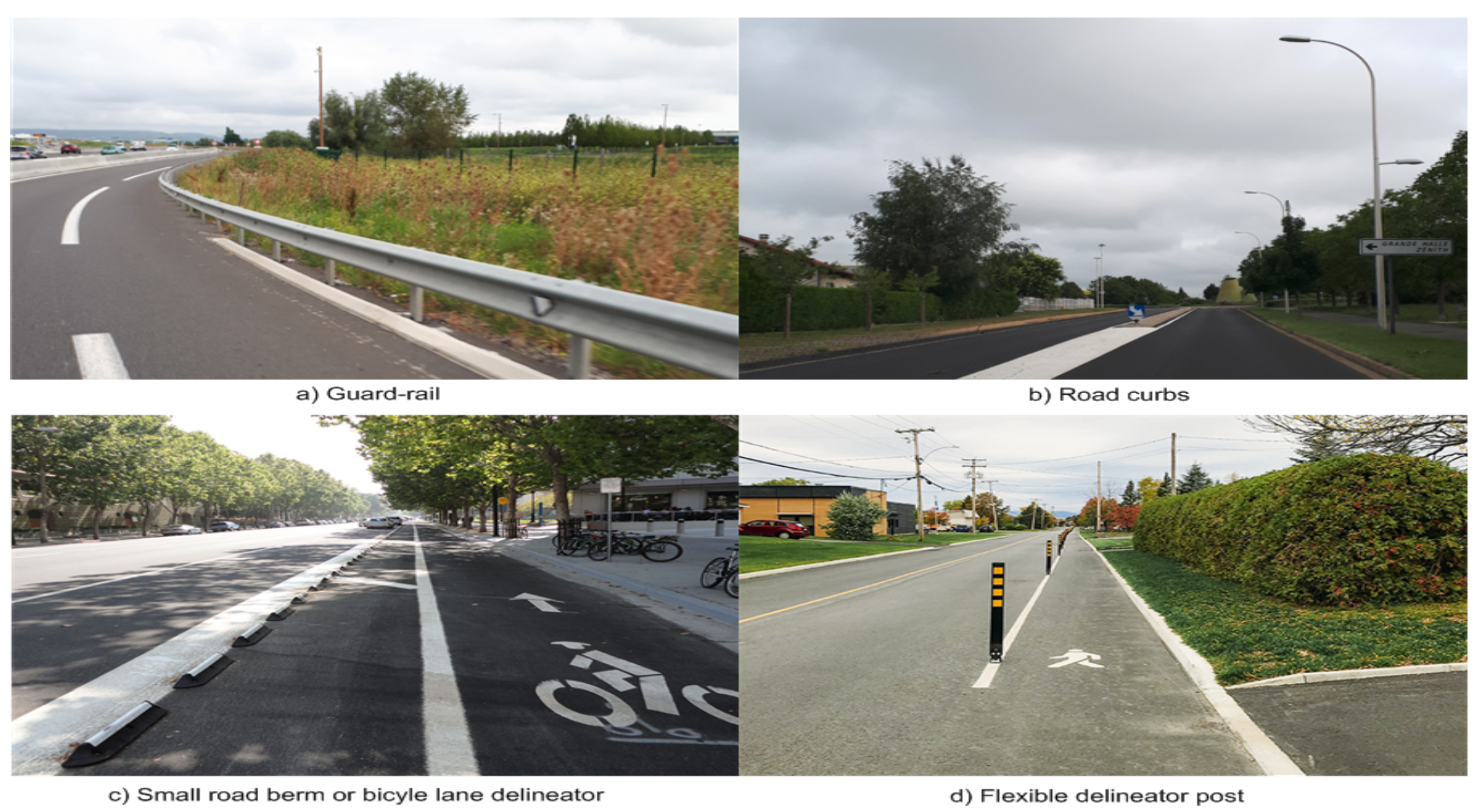




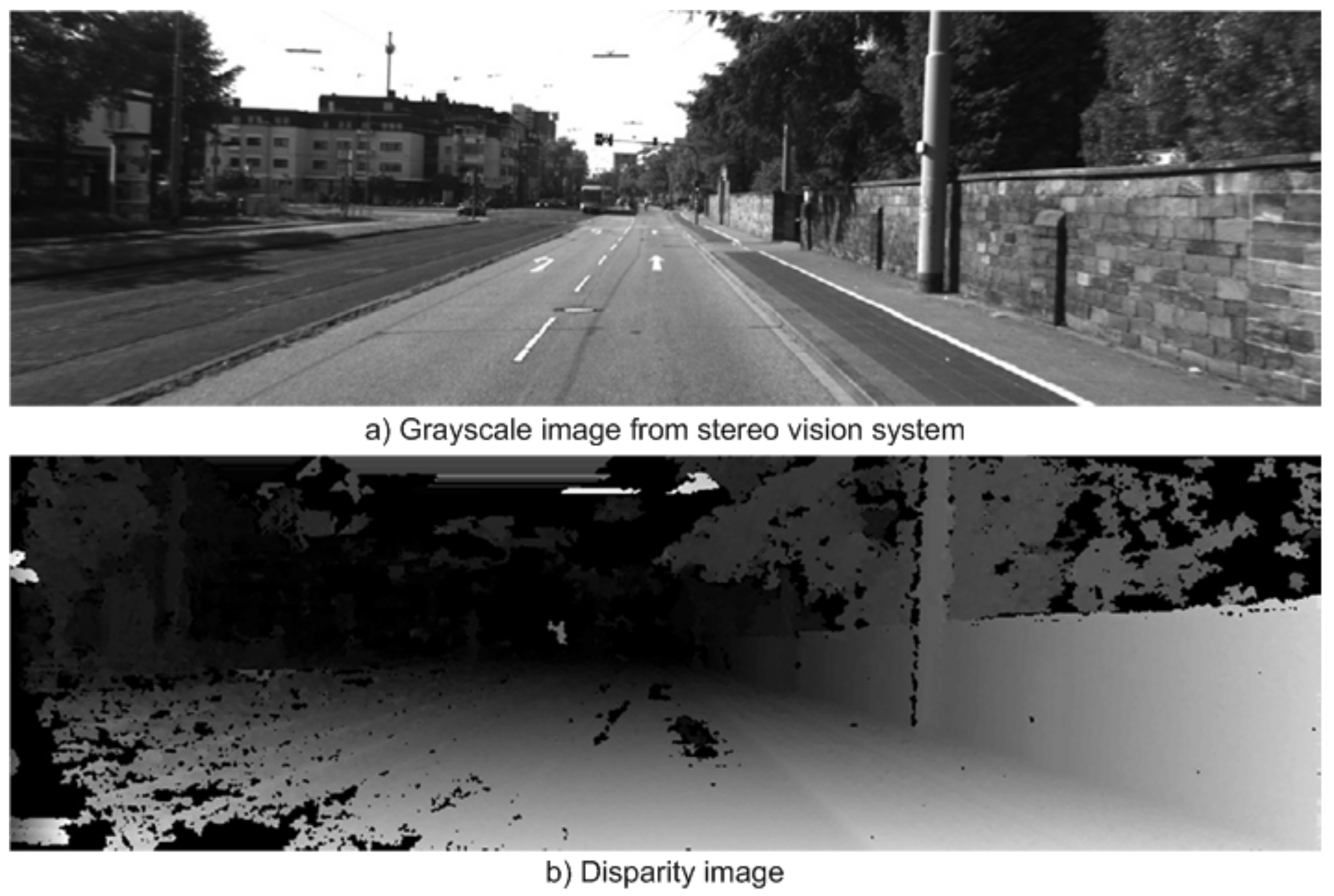




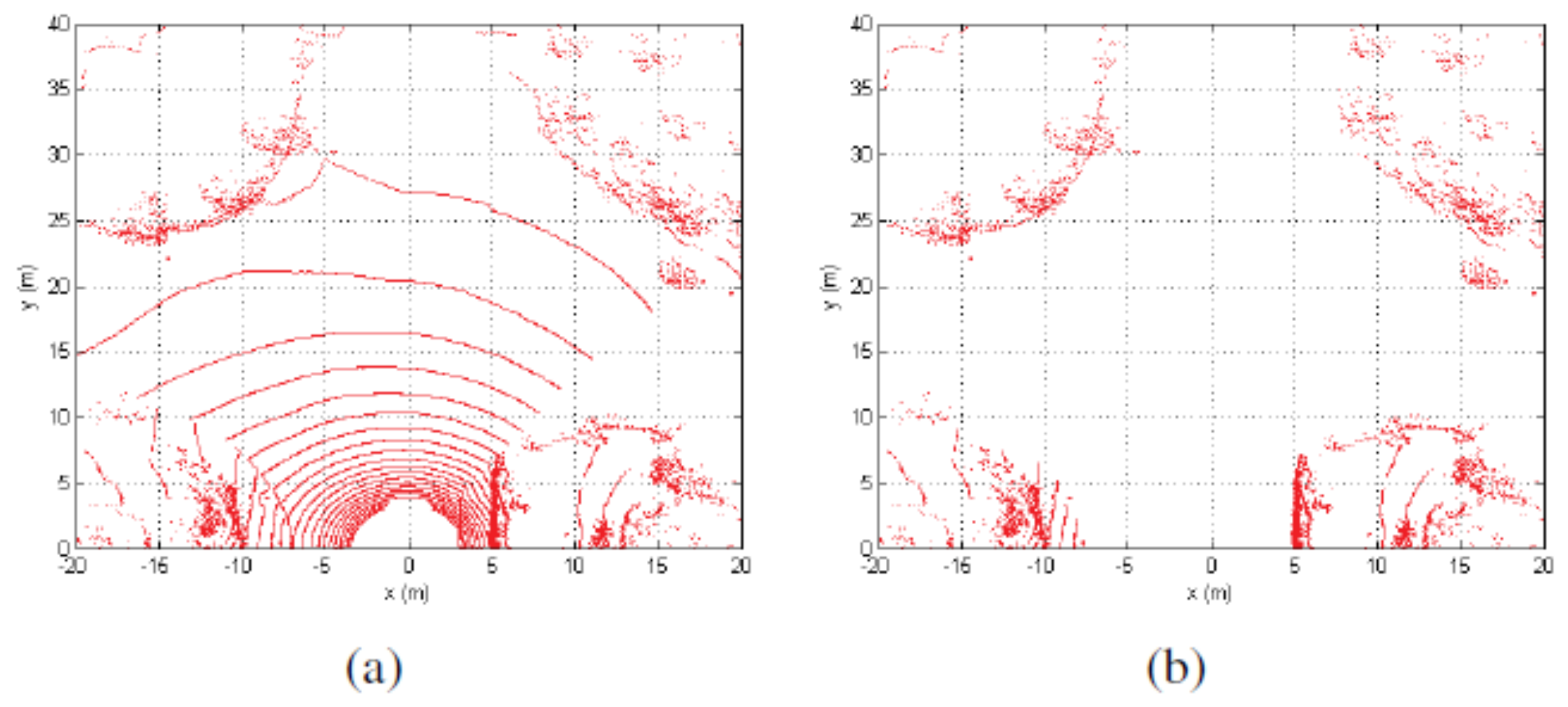
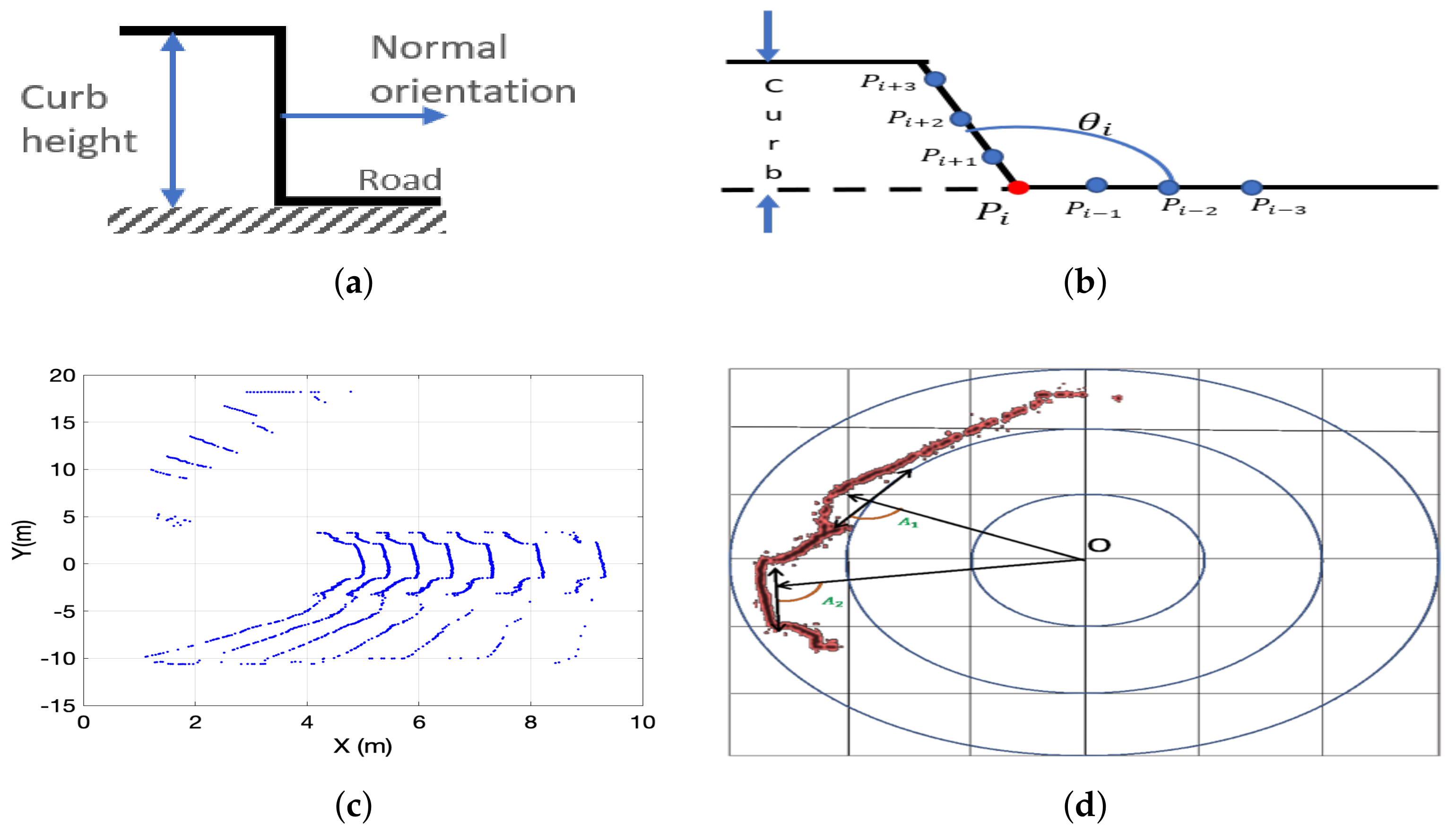



| Sensory Mode | References | |
|---|---|---|
| Vision | Monocular | Aufrere et al. (2003) [2] |
| Stereo | Oniga et al. (2007) [6]; Oniga et al. (2008) [7]; F. Oniga and S. Nedevschi (2010) [8]; Siegemund et al. (2010) [10] | |
| LiDAR | 2D | Wijesoma et al. (2004) [3]; Kim et al. (2007) [5]; Byun et al. (2010) [26]; Maye et al. (2012) [11]; Liu et al. (2013) [12], Liu et al. (2013) [13], Yu et al. (2015) [18], Lee et al. (2015) [23], Shin et al. (2010) [27], Byun et al. (2011) [43], Kim (2011) [44], Hervieu and Soheilian (2013) [45], Pollard et al. (2013) [46], Rejas et al. (2015) [47]. |
| 3D | Wang et al. (2005) [4], Liu et al. (2015) [17], Chen et al. (2015) [22], Wang et al. (2019) [24], Liu et al. (2014) [25], Tan et al. (2014) [30], Hata et al. (2014) [34], Yao et al. (2012) [37], Hata and Wolf (2014) [39], Hata et al. (2014C) [48], Yu et al. (2015) [49], Zhang et al. (2015) [50], Zhang et al. (2015B) [51], Huang et al. (2017) [52], Zhang et al. (2018) [53], Zhao et al. (2019) [54], Zhu et al. (2019) [38], Guerrero et al. (2020) [1], Ye et al. (2020) [55], Mi et al. (2021) [56], D. Rato and V. Santo (2021) [57] | |
| Ultrasonic | J. Rhee and J. Seo (2019) [40] | |
| Multi-modal | Mono + Lidar | G. Zhao and J. Yuan (2012) [19], Tan et al. (2014) [30], H. Qureshi and R. Wizcorek (2019) [35], Fernandez et al. (2015) [36], Chun et al. (2010) [58], Kuhner et al. (2019) [59], Ma et al. (2021) [42] |
| Fisheye + LiDAR | S. E. C. Goga and S. Nedevschi (2018) [33], Deac et al. (2019) [41] | |
| Stereo + Lidar | Tan et al. (2014) [30]; Fernandez et al. (2015) [36] | |
| Mono + stereo | T. Hu and T. Wu (2011) [60], Fernandez et al. (2017) [61] | |
| Authors | Stages of the Method | Advantages | Limitations |
|---|---|---|---|
| Aufrere et al. (2003) [2] | (a) Laser triangulation, (b) Histogram, (c) Definition of the interest zone, (d) Canny edge detector. | Low cost and real-time detection. | It only detects curbs on one side of the road. |
| Wijesoma et al. (2004) [3] | (a) Road geometry using extended Kalman filter, (b) Straight line model, (c) Eigenvector technique, (d) Scatter matrix | Application of ladar for road-boundary determination through curb detection | Extensive processing to filter the lines corresponding to the curbs and arbitrarily select the threshold |
| Wang et al. (2005) [4] | (a) CS Median Filter, (b) Gradient, (c) Vertical differential operator, (d) Threshold, (e) Mathematical morphology, (f) Hough Transform | Using the CS median filter to intensify the edge of the gradient | To get accurate and correct curb information, they need to filter the data acquired from the sensor. |
| Kim et al. (2007) [5] | (a) Mapping, (b) Hough Transform | Detects curbs on both sides of the host vehicle | It requires information from various sensors. |
| Oniga et al. (2007) [6] | (a) DEM, (b) Edge detection, (c) Hough Transform, (d) Circular mask, (e) Median filter | Detect curbs having a height of at least 5 cm | With depth the 3D points reconstructed by stereo vision are sparser, this due to the perspective projection |
| Oniga et al. (2008) [7] | Extension of [6] which adds a Persistence Map (PM), threshold and RANSAC | Detects few false curbs and removes curved curbs | Not stable in detecting non-sharp curbs (so-called traversable) |
| Peterson et al. (2008) [15] | (a) Geometric features, (b) Segmentation (ground and non-ground clusters), (c) Wavelet (edge detector for curbs) | Curb Detection is performed to achieve its primary objective; road limits | They process a large amount of data |
| Stuckler et al. (2008) [9] | (a) DEM, (b) Linear interpolations, (c) Normalization, (d) Filter, (e) Spline | They use curbs to locate lanes in the road network | The model only considers the DARPA road network |
| Byun et al. (2010) [26] | Used threshold, based only a difference in lateral distance | Decrease calculation time by using ROI instead of full image | They consider that the road is flat and horizontal. |
| Chun et al. (2010) [58] | Bayesian filter | Application in autonomous navigation | They may get incorrect measurements, depending on the road conditions and ambient light |
| Oniga et al. (2010) [8] | (a) DEM, (b) RANSAC, (c) Cubic polynomial, (d) Temporal Filter | The DEM is suitable for real-time processing and it reduces the processing space | They use different methods to determine the coefficients of the cubic polynomial; depending on the number of points |
| Zhao et al. (2012) [19] | They build a 3D cubic voxel grid using the point cloud. They separate the ground points from the point cloud and use three spatial cues to extract the candidate curb points: the elevation difference, the gradient value, and the normal orientation. | Consider curb detection on both sides of the road | To obtain the evidence map, the previous 5 frames are required with the current one. |
| Hata et al. (2014) [34] | They segment the road from the measurements returned from a LiDAR (Velodyne HDL-32E) into two parts: curbs and road surface. This information is trained on an ANN multilayer perceptron to classify the road into eight different models. They use an obstacle detection method based on ring compression to detect curbs. | Contributes mainly by making possible the detection of several road geometries | They require extracting detailed information from the road to train an ANN for road geometry classification. |
| Sodhi et al. (2016) [28] | (a) Disparity, (b) SegNet-Segmentation, (c) Potential (curvature, height map), (d) Dense CRF | They combine semantic, geometric, etc. consistency signals by formulating dense CRF for long-range curb detection. | Combination of both appearance and 3D reasoning for a more accurate segmentation |
| Zhang et al. (2018) [53] | (a) Point cloud data, (b) Sensor calibration/plane-based filtering, (c) Sliding-beam segmentation/Segment-specific curb detection | Application of the sliding beam method to segment the road and detect various road shapes. | They filter both on road points and off road points |
| Wang et al. (2019) [24] | (a) Point cloud data/the position and pose changes of each frame, (b) Ground segmentation, (c) Density-based method, classifies left and right candidate points for road curb detection, (d) Candidate points filtering method is proposed which consists of distance filter and RANSAC filter, (e) Tracking, use an amplitude limiting Kalman filter to smooth the fluctuation of the road curb curve. | They only consider on-ground points for curb point extraction | They apply two filters: a distance filter and a RANSAC filter, to remove false points |
| J. Yu and Z. Yu (2021) [77] | (a) A mono-vision based lateral localization system, (b) CRoI module is proposed to obtain the curb region of interest, (c) semantic segmentation module based on the combination of U-Net and SCNN. | Efficient, low cost and less complex | The road scene classification module classifies road scenes only into three classes |
Publisher’s Note: MDPI stays neutral with regard to jurisdictional claims in published maps and institutional affiliations. |
© 2021 by the authors. Licensee MDPI, Basel, Switzerland. This article is an open access article distributed under the terms and conditions of the Creative Commons Attribution (CC BY) license (https://creativecommons.org/licenses/by/4.0/).
Share and Cite
Romero, L.M.; Guerrero, J.A.; Romero, G. Road Curb Detection: A Historical Survey. Sensors 2021, 21, 6952. https://doi.org/10.3390/s21216952
Romero LM, Guerrero JA, Romero G. Road Curb Detection: A Historical Survey. Sensors. 2021; 21(21):6952. https://doi.org/10.3390/s21216952
Chicago/Turabian StyleRomero, Lucero M., Jose A. Guerrero, and Gerardo Romero. 2021. "Road Curb Detection: A Historical Survey" Sensors 21, no. 21: 6952. https://doi.org/10.3390/s21216952
APA StyleRomero, L. M., Guerrero, J. A., & Romero, G. (2021). Road Curb Detection: A Historical Survey. Sensors, 21(21), 6952. https://doi.org/10.3390/s21216952






